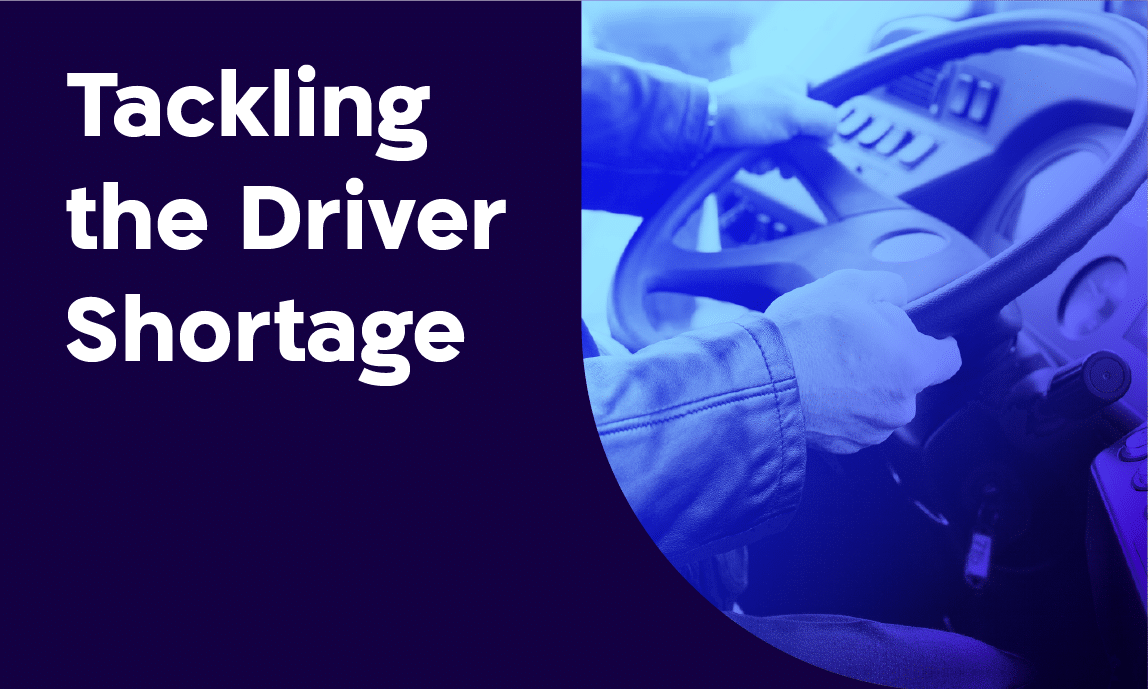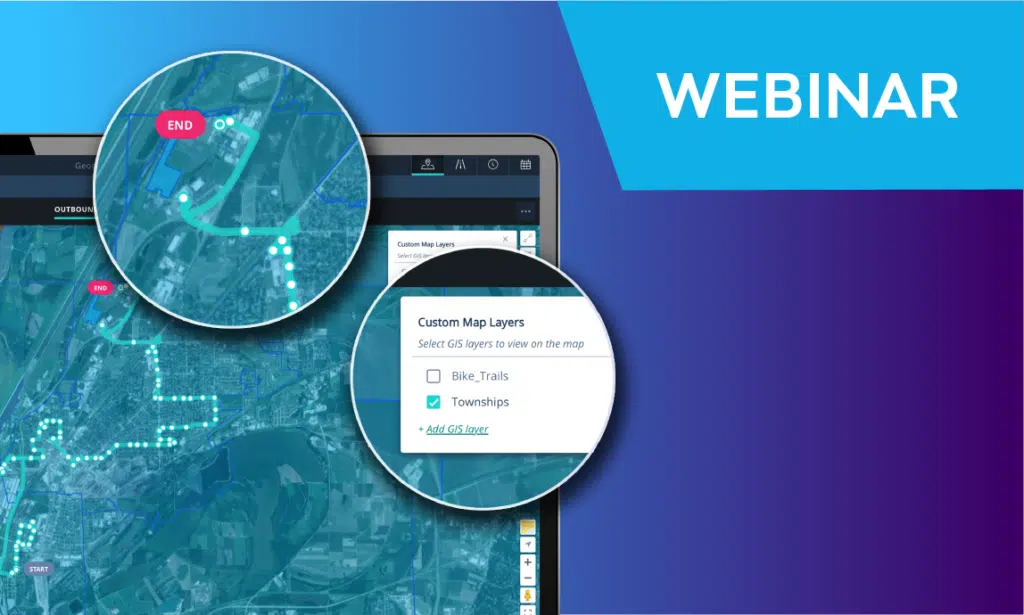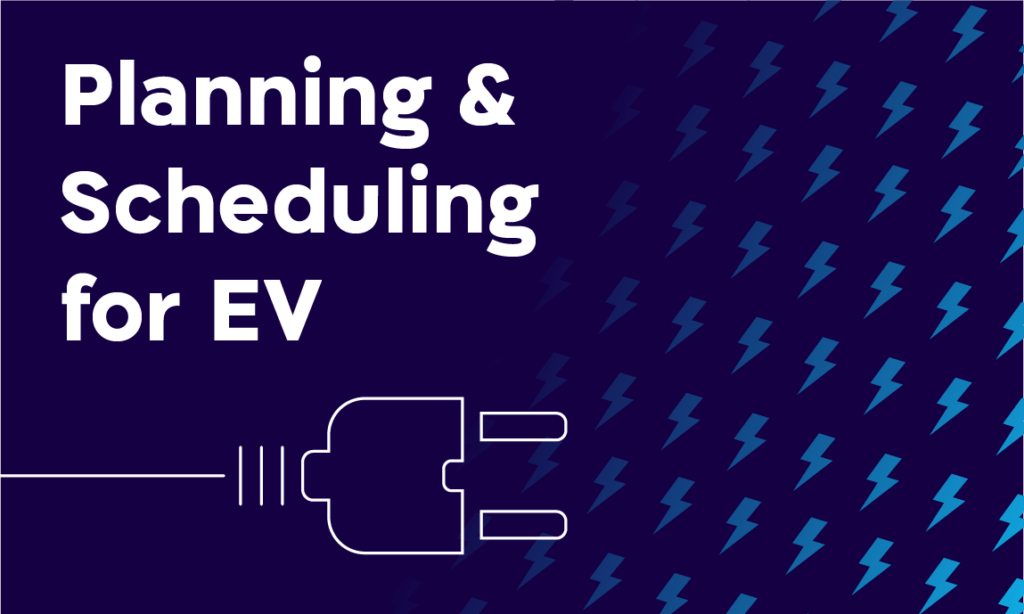To state the obvious, transportation planning is an extremely complicated process, involving many crucial, yet oftentimes conflicting factors and components.
In order to effectively plan more optimal routes, you must not only weigh your organization’s needs — whether they involve budget restrictions, union rules and requirements, peak vehicle requirements (PVR), on-time performance (OTP), and otherwise — as well as the needs of your drivers, passengers, and the greater community that you’re serving.
No matter how simple or complex your network may be, there are some general best practices that every Planner should be considering throughout the transportation planning process.
To help make this complicated task a little less arduous, we’ve comprised this helpful list of 5 pivotal best practices to consider as you plan your routes and network.
By incorporating the principles below, you can create routes that are more optimal, efficient, and equitable for all.
1. Equity and Accessibility
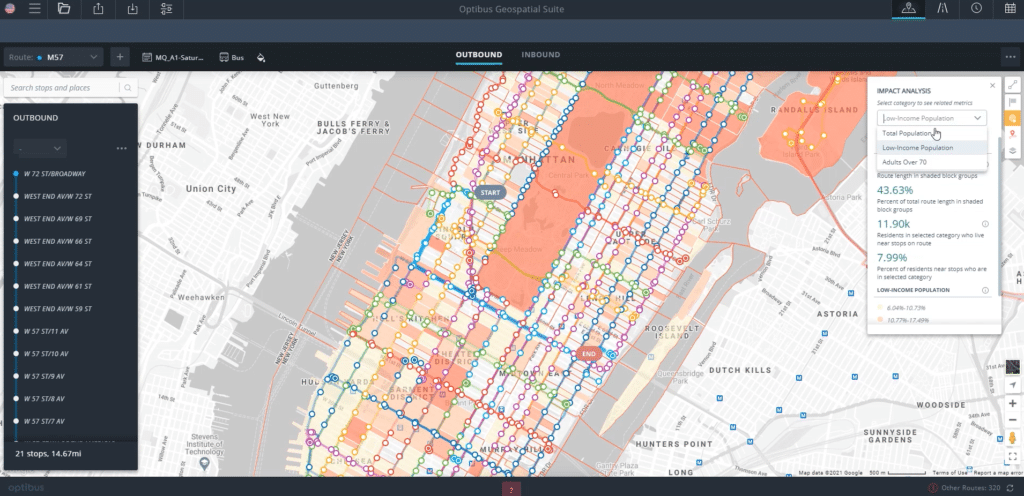
When planners have a better understanding of their passengers’ needs — and how they’ll get to and from each area of interest within their communities — it helps them build more inclusive, vibrant, and transportation-oriented cities. It also helps progress toward transportation equity.
Residents of transportation deserts are often from historically marginalized demographic groups, some of which have been systematically denied services, and/or are low-income workers who cannot afford a personal car — and thus rely on public transportation for mobility.
As such, increasing access to public transportation in these neighborhoods is truly imperative. So how can you ensure that your routes are equitable, inclusive, and well-suited to everyone within your community?
A great place to start is by having the right data at your disposal — and for this, Optibus’ Geospatial Suite can definitely help.
With our Custom Map Layers, you can easily leverage the power of GIS data to create more inclusive routes. You can view crucial data on areas of interest directly on the map as you plan your routes, including: commercial districts, bike paths, rail networks, schools, health clinics, COVID-19 testing and vaccination sites, and much more.
This way, you can build routes that truly reflect the needs of the local community.
Additionally, through our Impact Analysis feature, you can visualize vital demographic data (e.g. low-income populations, older adults) as you plan your routes, for a deeper understanding as to how different demographic groups will be impacted by any changes made to your network.
All of this enables you to create more equitable, accessible routes for all — and ensure that your routes truly reflect the needs of everyone within your community.
2. Ridership Analysis
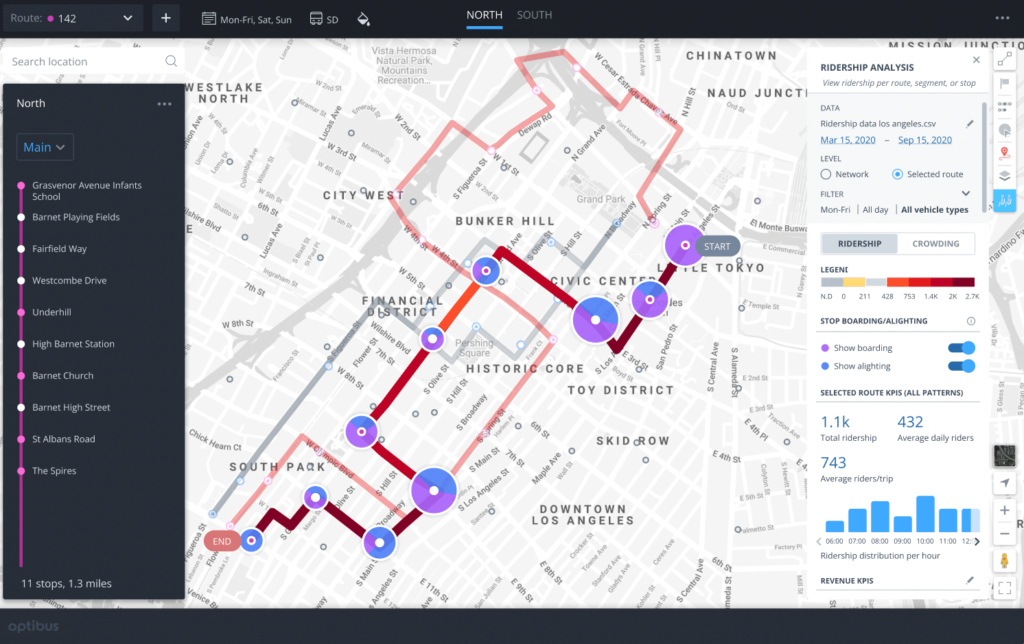
In addition to creating more equitable, accessible routes, another imperative — yet highly challenging — aspect of transportation planning is that of planning your routes based on your ridership levels.
In other words, using your ridership data to attempt to match the “supply” of your passengers to the “demand” of your service offering.
To do this, you should ideally have the ability to analyze the number of passengers across your network — and make adjustments to your routes to reflect this. The areas with greater demand for your services should have more frequently running routes and ample access to your services, and vice versa.
In order to gain a deeper understanding as to which areas of your routes are experiencing greater or lower levels of ridership — once again, you’ll need access to the right data to make data-driven decisions.
One solution that can help with this is our new Ridership Insights feature, as it gives you vital insights into how your routes are performing.
With Ridership Insights, you can easily upload APC data reports to view your ridership KPIs on a route, segment, and stop level (with boarding and alighting stats) — color-coded and filtered by route, day, and time.
You can then theoretically leverage this data to make adjustments to your routes as needed. For example, if you see that one stop on your route has very few passengers getting on, you might want to consider removing this stop from your route — and focusing on providing more services to other areas with higher ridership levels.
3. Passenger Satisfaction

In addition to everything mentioned above, as you plan out your routes, you obviously want to do so in a way that will provide an optimal passenger experience. If you fail to do so, you’ll not only face potential fines — but you’ll end up with dissatisfied passengers, and thus significant drops in ridership over the long term.
To provide your passengers with a truly satisfying experience, you want to make your service as convenient for them as possible — planning routes that are likely to run on time, thus minimizing their wait times.
In theory, that may sound easy to do, but in reality, this is much easier said than done. Fortunately, with our latest set of features, optimizing your on-time performance (OTP) just got a whole lot easier.
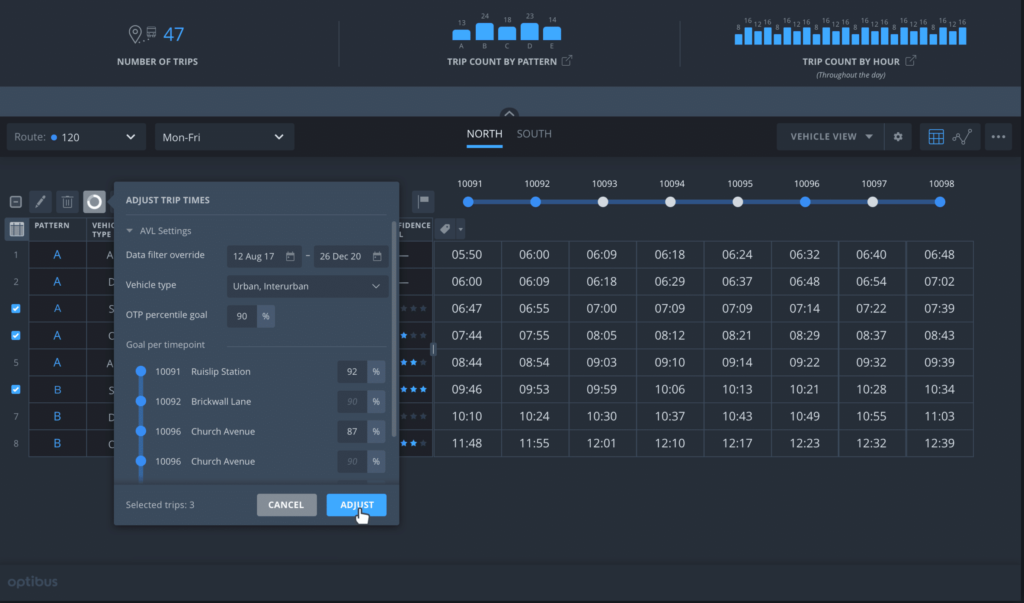
With our upcoming Predictive Runtimes feature, you can calculate the OTP for any given trip on your timetable — or even generate new trip times in seconds based on your desired OTP goal (e.g. 90%). You can also view a detailed breakdown of your OTP data, delays, and even journey replays with our upcoming Performance Insights feature.
Furthermore, using Transit Alerts by Trillium, an Optibus company, you can easily communicate with your passengers in real time, to notify them about service disruptions, detours, long wait times, and more — thus increasing passenger satisfaction.
Over time, planning routes and timetables with passengers’ needs in mind will ultimately lead to a greater level of service, more satisfied passengers, and increased passenger retention.
4. Safety
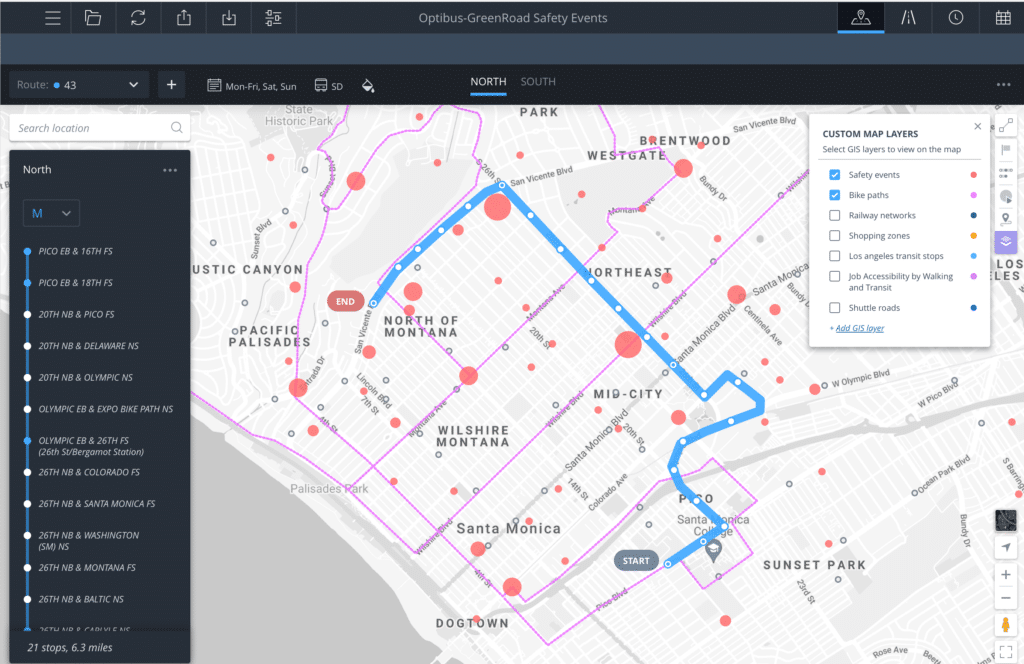
Another key component to keep in mind as you’re planning your routes is that of safety — for your passengers as well as your drivers. Obviously you want your routes to run as safely and smoothly as possible.
Fortunately, there are certain measures you can take to create more safety-driven routes. Once again, this is where visualizing your data as you plan your routes becomes essential — and Optibus is here to help.
Thanks to our recent GreenRoad partnership, you can harness GreenRoad’s Safety Heat Map to visualize and assess the safety score of existing routes within your network on the map.
You can use this functionality at the network planning stage to account for safety factors such as road and ride quality, collisions, injuries, and driver behavior including speeding, sudden acceleration and braking, and sharp turns.
Plus, you can even re-plan low-scoring routes to avoid hazard areas and increase safety, assess the impact of rerouting on the entire network, and support local authorities in identifying and fixing road hazards.
By optimizing route safety, you can reduce the number of injuries across your routes, and produce a smoother ride that reduces risk and increases safety for your passengers and drivers, thus increasing their satisfaction and trust.
5. Sustainability and Vehicle Efficiency

At the end of the day, one of the reasons why public transportation is so imperative is because of its ability to significantly reduce CO2 emissions.
As you plan your routes, you should always remember in the back of your mind that the more people you can get out of their private cars — and onto public transportation — the better.
Thus simply by planning more optimal, appealing routes via the principles above — routes that better reflect your passengers’ needs, preferences, and lifestyles — you’re also helping to contribute to a more sustainable future.
If you’re looking for additional ways to reduce your organization’s emissions (and costs, especially considering recent increases in fuel prices), we recommend you consider transitioning your fleet(s) to include more — if not all — electric vehicles (EVs) in the near future.
That said, while EVs are a crucial component in the move toward zero emissions, they do present significant planning and scheduling challenges — requiring that elements such as charging times, charging location, and battery levels be taken into account.
Optibus is supporting our partners in their accelerated shift to electric and hydrogen bus adoption with our specialized Electric Vehicle module, using EV-specific metrics to create the most integrated, optimal operational and charging plan.
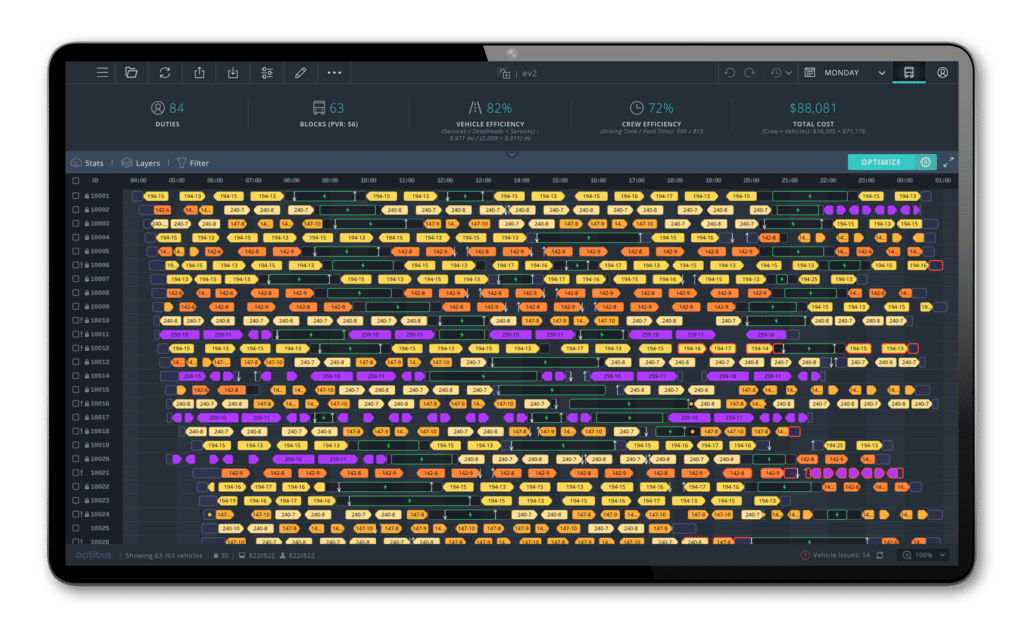
Last but not least, another great way to plan more sustainable routes is by merely by reducing waste on the road — using fewer vehicles to operate your routes whenever possible.
With Optibus’ new Timetable Optimization feature, you can do exactly this. Our advanced algorithm finds possibilities to reduce your PVR and operational costs (thus using fewer vehicles when possible), while still meeting your ridership and service level needs.
More efficient, sustainable routes are not only better for the environment — they’re also much more cost-effective, and can result in significant cost savings for your organization. To put it simply, planning with sustainability in mind is a total win-win.
Making public transportation better. Together.
We hope this information serves as a helpful resource for you, and that you’ve taken away some valuable best practices that you can begin to incorporate across your routes and network.
If you’re looking for a solution to support you in making more data-driven decisions throughout the transportation planning processes, we highly recommend you check out the Optibus Planning module.
It’s cloud-native, simple and intuitive to use, and is constantly evolving and improving based on our partners’ input and preferences. Optibus Planning empowers you to plan, analyze, and optimize your network with unprecedented speed, ease, and accuracy.
With our holistic solution, you can factor in all your strategic and operational planning needs — from accessibility and safety to your level of service — while improving visibility and efficiency across your entire organization.
Here’s a short demo video showcasing (just some of) what our Planning module can do:
To learn more about the Optibus Planning module — and find out how it can help you plan more equitable, sustainable, and better-performing routes — we welcome you to check out our recent webinar, or to book a personalized demo here.
We’re here by your side for every step of your journey, and look forward to helping you make public transportation better. Together.
Read more:

